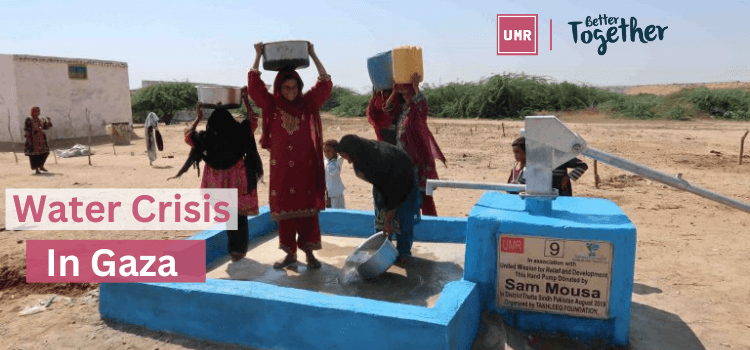Palestinians in Gaza recall an era when nearly everyone had access to clean water from the pipe. The water crisis in Gaza is increasing day by day.
Today, less than 4% of freshwater is safe to drink. Sewage pollution has contaminated the sea nearby. However, the global community is not doing enough to safeguard the health and dignity of nearly 2 million individuals who are without a place to go. Gaza water pollution
Emergency Crisis
Gaza has long struggled with access to clean water and sanitary facilities. But now an emergency exists there. Its twofold water issue entails both a lack of sewage sanitation and a shortage of drinkable water for drinking, cooking, and personal hygiene. As a result, Gaza regularly discharges approximately 108,000 cubic meters of untreated sewage into the Mediterranean Sea, posing serious risks to the public’s health in Gaza, Israel, and Egypt.
Even though these problems have been around for a long time, the water crisis and health worries about drinking water have gotten worse.
There are many reasons for this, such as :
- Infrastructure is breaking down quickly
- Strict import restrictions on building materials and water pumps
- The energy supply is unstable and getting less
The restoration of Gaza’s water and sanitation sectors has been further hampered by wars between Israel and Hamas since 2009 and an internal Palestinian conflict between Hamas and Fatah.
Causes of the Water Crisis
War is the main cause of Gaza water pollution. Gaza water distribution supply has been greatly disrupted by the Israeli-Palestinian war. The main water sources in the area, including the Jordan River and the Coastal Aquifer, are under Israel’s authority. Israel limits the amount of clean water that is accessible to Palestinians by limiting the amount of water allotted to Gaza. It has affected the people of Gaza in many ways. Here are some of the destructions which break the water system in Gaza completely –
Collapsed Infrastructure
Gaza’s water system has been in bad shape for years. Because :
- Years of neglect
- Inadequate maintenance
- Damage caused by wars
The aging infrastructure is prone to leaks, inefficiencies, and frequent breakdowns. It results in significant water losses. The deteriorating infrastructure further limits the availability and accessibility of clean water for the population.
Import Bans On Materials
The restrictions on what Gaza can import, especially building materials, make it very hard to build and keep up good water facilities. This includes putting limits on the import of pipes, pumps, and other tools needed for water and sewage systems. Because there aren’t enough of these important materials, it’s hard to build new infrastructure and fix the damage, which makes the water problem worse.
Insufficient Energy Supply
Gaza depends on energy a lot to run water pumps, desalination plants, and facilities that clean up waste water. But Gaza’s energy supply is very irregular because of things like
- Fuel shortages
- Limited access to electricity
- Damage to power facilities caused by wars
When there isn’t enough energy, water facilities can’t work properly. This makes it harder to make, treat, and distribute clean water, which makes the water problem worse.
Impact Of Water Crisis In Gaza
The impact of water crisis in Gaza is greater than anyone’s imagination. Here are some of the key effects:
Limited Access to Clean Water
Gaza’s population faces severe challenges in accessing sufficient quantities of safe and clean water for drinking, cooking, and personal hygiene. Due to water scarcity, households often receive water for only a few hours every few days, leading to rationing and difficulties in meeting basic needs.
Health and Hygiene Challenges
Inadequate access to clean water and poor sanitation facilities contribute to numerous health risks. Contaminated water sources and the lack of proper wastewater treatment systems increase the spread of waterborne diseases such as diarrhea, cholera, and typhoid. Limited water availability also hampers proper hygiene practices. It leads to poor sanitation and an increased risk of infections and illnesses.
Impact on Agriculture and Food Security
The water crisis has had a significant impact on agricultural activities and food production in Gaza. Limited water resources restrict irrigation for crops, negatively affecting agricultural productivity. Farmers face difficulties in growing crops, resulting in reduced yields and lower-quality produce. This situation jeopardizes food security for the population, leading to increased dependence on food aid and imports.
Economic Consequences
The water Palestine crisis imposes economic burdens on individuals and communities. As water becomes scarce, the cost of purchasing water from alternative sources increases, putting financial strain on households already facing economic challenges. Additionally, the limited availability of water restricts economic activities such as small-scale industries, hampering job opportunities and economic development.
Gender Disparities and Burden
Women and girls in Gaza bear a disproportionate burden due to the water crisis. In many households, women are primarily responsible for collecting and managing water. The scarcity of water in Gaza is impacting the women greatly..
Humanitarian Efforts and International Response
There hasn’t been much international financing to support immediate humanitarian initiatives, complete reconstruction, and revive the private sector economy. This covers medium- to long-term infrastructure initiatives in the fields of public health, water, sanitation, and hygiene (WASH), and energy.
A $244 million financing shortfall was mentioned as a hindrance to the 2014 war’s reconstruction, which included harm to homes, hospitals, and water and energy infrastructure. After the conflict, international donors pledged $3.5 billion for rehabilitation, but only $1.5 billion has actually been paid out. This illustration brings to light one of the most difficult financing issues surrounding Gaza: a lack of donor follow-through. Furthermore, less than half of the $547 million Humanitarian Response Plan for the Palestinian Territories for 2017, which is primarily focused on Gaza, has been allocated. The WASH component is notably underfunded in Gaza.
United Mission for Relief & Development (UMR) has been working hard to solve the water problem in Gaza. They have worked on many water relief projects to help the Palestinian people and find long-term answers to their problems. Their work includes giving out emergency water supplies when there is a severe lack of water, putting in place systems to clean water in communities, and fixing up water facilities.
UMR also works on education and awareness programmes to teach people how to save water, practise good hygiene, and understand how important it is to manage water in a sustainable way. They with local partners are still fighiting to find long-term solutions to Gaza’s water problem. Your donation will help them to assure safe water for the people of Gaza.
Potential Solutions and Future Outlook
Gaza water crisis solutions are not impossible but hard to implement. Here are some of the possible solutions for the water crisis in Gaza –
- Increase the quantity and consistency of Gaza’s electricity supply through various investments and infrastructure improvements.
- Advance the “161kV Line” project to enhance the transmission of electricity to and within Gaza.
- Upgrade and expand the electricity transmission network in Gaza to ensure efficient distribution.
- Restore the fuel storage tank at the Gaza Power Plant and connect it to a natural gas pipeline to improve the power generation capacity.
- Invest in solar energy to diversify the energy sources and reduce reliance on external suppliers.
- Explore the development of the Gaza Marine gas field to enhance the availability of natural gas for power generation.
- Increase the supply of purchased power from Egypt to augment the electricity supply in Gaza.
- Ensure a consistent supply of electricity for the Khan Yunis Short-Term Low-Volume desalination plant, enabling continuous water production.
- Improve fee collection mechanisms to cover the ongoing cost of electricity and support sustainable operations.
- Investing in new solar energy initiatives could increase the resilience of crucial infrastructure.
Gaza Needs Help
To implement the solutions mentioned above, Gaza needs a tremendous amount of funding from all over the world. We all should come forward and help to solve the water crisis in Gaza. Donate to international organizations working for Palestine like UMR. One small donation will impact greatly on the lives of the people in Gaza.














